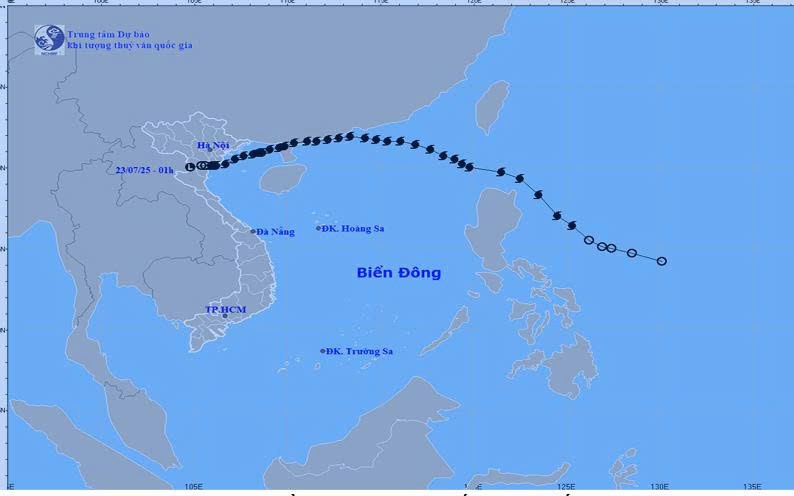The telegram stated that Typhoon No. 3, internationally named Wipha, had made direct landfall in Vietnam with sustained winds of level 9–10 (approximately 47–61 mph), gusts reaching levels 11–12 (up to 74 mph), heavy rainfall, storm surges, and widespread coastal flooding.

Storm No. 3 projected path as of 1:00 AM on July 23, 2025.
In Nghe An Province, especially severe flooding occurred in the upper reaches of the Ca River. The inflow to the Ban Ve reservoir exceeded the designed flood capacity, resulting in extensive inundation across riverside communities. Several areas experienced failures of dikes and dams, flash floods, and landslides that severely disrupted residents' lives and economic activities.
The Government and the Prime Minister closely monitored the situation and issued three directives to ensure early and proactive responses. These directives emphasized urgency, decisiveness, composure, and timely, effective actions in line with the storm’s developments.
The Party Central Secretariat also issued guidance, instructing Party organizations at all levels, state agencies, the Fatherland Front, and socio-political organizations to remain vigilant. It called for strengthened leadership, inspection, and coordination to respond effectively to the typhoon.
Key ministries, particularly the Ministries of Agriculture and Environment, National Defense, and Public Security, along with provincial and municipal authorities, actively participated in coordinated responses. Their close on-the-ground engagement, combined with the proactive efforts of local communities, helped minimize loss of life and property while reducing the storm’s negative impact on livelihoods.
In many areas, the two-tier local government model has begun operating smoothly and effectively, maintaining close connections with communities and applying the “four-on-the-spot” principle in natural disaster prevention and control.
To quickly recover from the impacts of Typhoon No. 3 and the floods, and to restore production and stabilize people's lives, the Prime Minister directed Chairpersons of the People's Committees in the affected provinces and cities to urgently implement all necessary measures. These include mitigating damage, restoring agricultural activities, promptly draining flooded fields, and protecting newly planted rice, vegetables, and other economically valuable crops.
Local authorities must swiftly review, verify, and accurately assess storm and flood-related damages. They should promptly allocate contingency funds and local resources to implement support policies for affected groups, especially the poor, disadvantaged households, policy beneficiaries, and vulnerable individuals, in compliance with regulations.
They must also prevent loss, waste, corruption, or misconduct. If a local budget is insufficient for support measures, the provincial People's Committee should submit an official request to the Ministry of Finance for assistance under existing regulations.
At the same time, local governments are instructed to prepare and submit by July 24, 2025, a comprehensive report to the Prime Minister. This report must include assessments of the storm and flood situation, leadership and response efforts, successes and challenges, unresolved issues, lessons learned, and proposed solutions.
The Prime Minister requested the Ministers of National Defense and Public Security to direct military and police forces to prepare personnel, equipment, and supplies to assist localities in overcoming the disaster's aftermath upon request.
The Minister of Agriculture and Environment must oversee the implementation of coordinated recovery efforts and ensure the resumption of agricultural production. The Ministry must also review and promptly repair damaged irrigation reservoirs and dike systems to prepare for future heavy rainfall and floods.
In addition, the Ministry must gather and consolidate requests from local authorities and, in coordination with relevant agencies, resolve them within its jurisdiction or escalate them to higher authorities. These requests may involve assistance with supplies, chemicals, crop seeds, and livestock to resume agricultural activities.
The Minister of Industry and Trade must instruct localities and hydropower plant operators to develop and implement plans to ensure the safety of hydropower dams, particularly in cases of extreme rainfall exceeding design thresholds. The Ministry must also direct the Vietnam Electricity Group to maintain nationwide electrical grid safety.
The Minister of Construction is tasked with ensuring traffic safety and promptly addressing landslides along transportation routes to maintain uninterrupted traffic flow, especially on major roads.
The Ministry of Finance is responsible for coordinating with relevant agencies to promptly process, or escalate to competent authorities, local requests for financial support to recover from storm and flood damages in accordance with regulations.
The Prime Minister assigned Deputy Prime Minister Tran Hong Ha to continue directing ministries, sectors, and localities involved in the recovery efforts following Typhoon No. 3 and subsequent flooding.
The Government Office will monitor and coordinate the execution of this Official Telegram in accordance with its assigned functions and duties. It will report in a timely manner to the Prime Minister and the responsible Deputy Prime Minister regarding any obstacles or challenges arising during implementation.